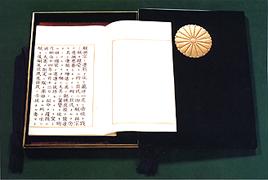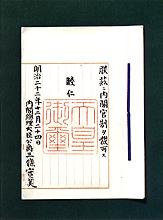|
Under the Constitution of the Empire of Japan promulgated on February 11, 1889, the Emperor had the complete right of sovereignty. While the Constitution stated, "The respective Ministers of State shall give their advice to the Emperor, and be responsible for it." (First paragraph of Article 55) there was no stipulation on the Cabinet itself.
The Constitution was based on the principle that the Emperor himself exercised the administrative power, enlisting the aid of State Ministers. The Cabinet was therefore primarily established as a consultative body to assist the Emperor. It also had the function of a forum where State Ministers adopted state policies and engaged in discussion to ensure that such policies were consistent with those of the state.
On December 24, 1889, Naikaku-kansei was promulgated as a guideline for management of the Cabinet system. Although this Naikaku-kansei largely took over the contents of its predecessor, Naikaku-shokken of 1885, it weakened the controlling power of the Prime Minister over State Ministers.
Naikaku-kansei, though partially amended in 1907, was in force for about 60 years until the Cabinet Law was enacted in 1947.
The Constitution of the Empire of Japan did not refer to the status of the Prime Minister in particular. In terms of giving advice to the Emperor, the Prime Minister ranked with his colleagues as one of the respective Ministers of State.
Naikaku-kansei stated that the Prime Minister "shall report state affairs to the Emperor as a chief among ministers, receive the Emperor's instruction, and maintain the unity among the different branches of the administration." (Article 2) In the above, "chief" just meant "prima inter pares."
|

